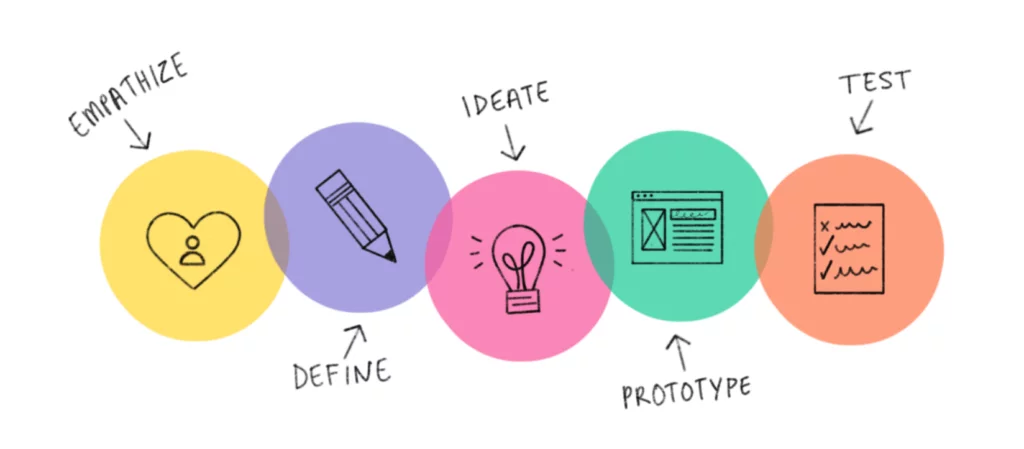Design thinking is one of many design approaches that can help product teams create designs that are more relevant, useful, and delightful. As a result, products will perform better in the marketplace, generate more revenue, and attract a larger audience.
In this article, we’ll learn what design thinking is, how it compares to other design approaches, and how a comprehensive “design toolbox” can help product teams improve the entire product life cycle.
Design thinking defined
Design thinking is an approach to problem-solving that is aimed at helping teams see problems from different angles, then develop new and innovative solutions.
According to the Interaction Design Foundation, design thinking consists of five key steps:
Empathize. Research users’ needs in order to gain an empathetic understanding of their problems and needs.
Define. Clearly articulate their problems and needs in a series of problem statements.
Ideate. Look at new ways of viewing the problem and identify innovative solutions.
Prototype. Begin experimenting with prototypes of the solution.
Test. Test the prototype, learn, redefine further problems, then develop other iterations if necessary.

There are other types of design thinking, though they often revolve around the same basic ideas.
According to MIT Sloan Management, for instance, design thinking consists of four steps:
- Understand the problem
- Develop possible solutions
- Prototype, test, and refine
- Implement
The number of steps clearly differ, but we can also see that the underlying methodology remains the same.
IDEO, likewise, advocates a six-step design thinking process that is very similar to both of the above.
For product designers and developers, this approach to problem solving can certainly help team members stay innovative, which is becoming more and more necessary in today’s fast-paced environment.
However, design thinking is not the only tool in a product team’s toolbox – there are several other useful frameworks that should be incorporated into product workflows.
Beyond design thinking: Creating a “design toolbox”
Design thinking is an excellent approach to product development, especially when it is combined with other product design methods.
Below, we will look at few prominent design approaches that can be combined with design thinking to enhance product development.
User-centered design. User-centered design is a design approach that, as the name suggests, develops designs around the users, rather than around preconceived ideas, designers’ preferences, and so forth. This approach consists of specific stages: plan, analyze, design, and test and refine.
Human-centered design. Human-centered design is similar to user-centered design, in that it is specifically built around people. This design approach develops interactive systems via participatory action research, human input, and a variety of other tools to develop solutions that benefit humans.
Lean product development. Lean is a well-known approach to product design that also focuses on users, rather than predetermined plans or preconceived notions. The product development cycle consists of three stages: build, measure, and learn. Benefits of this approach include decreased time-to-market, less waste, and products that are more relevant to users.
Usability and utility. Usability describes how easy a product is to use. When a product is navigable and learnable, for instance, users will be able to start using it more quickly. They will also be able to remember it more easily the next time they use it. The more usable a product is, the more likely users are to continue using it for the long term.
Experience design. The user experience embraces all of the user’s experiences and interactions with a brand, product, or service. Like most other design approaches, experience design is built around fundamental components aimed at improving the end product or service. According to one model, good user experiences should be built around principles such as usefulness, usability, value, and accessibility.
Along with design thinking, all of these approaches can be very useful when developing one’s own products.
However, it is also important to realize that these same approaches can be used throughout the product experience life cycle, not just the design phase.
Design thinking: From development to adoption
Design and development continue even after a product reaches the marketplace. Customers continue to provide feedback, new features are added, bugs are fixed, and new iterations are released.
However, there is another key piece of the product life cycle that is often overlooked: product adoption.
Product adoption, or digital adoption, means that users can use digital tools as they are intended and to their fullest extent.
A product’s design certainly affects how easily users can learn and adopt a new tool – but it is only one of several factors that impact the product adoption cycle.
Design thinking can also be used to solve other stages in that cycle, such as:
User onboarding. First impressions matter, in both software and life. The first time a new user opens up a new application, they are confronted with an entirely new interface. At this point, it is essential to provide a product tour or a walkthrough, which can dramatically reduce abandonment rates.
Training. To actually realize a product’s value, users must actually be proficient with it. Training remedies that problem, improving users’ proficiency, productivity, engagement, and satisfaction. It is important to note, though, that not all training is created equal. The best option is in-app training, offered through digital adoption solutions, since information is contextualized and immediately relevant.
Self-service. Users will inevitably have questions about tasks or workflows. Though human technical support should always be an option, automated self-service can decrease wait time and technical support costs. Chatbots, for instance, can be used to provide in-app support, without requiring human intervention.
By approaching adoption through the lens of design, product teams can find new and innovative ways of improving important user metrics, such as time-to-productivity, user satisfaction, and user retention.
Final thoughts: Redesigning for a new era
At the time of this writing, the COVID-19 pandemic is still underway, and businesses around the world are rethinking their products and product adoption strategies.
In today’s remote world, it is more important than ever to design great products and great user experiences.
Design thinking and the other design strategies mentioned above are a must, but it is equally important to have a powerful product adoption plan.
Digital adoption solutions give product teams an edge when onboarding and training new users. DAP greatly simplifies user onboarding, training, and self-service, which, in turn, dramatically shortens learning curves and boosts user engagement.


